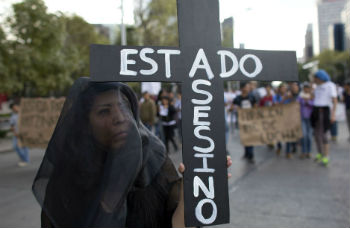A recent academic study argues that state institutions directly contribute to Latin America’s high levels of violence to a much greater extent than contemporary scholarship has suggested, potentially providing a new perspective on the best way to reduce homicides in the region.
Author José Miguel Cruz begins by noting that “Most explanations of the high levels of violence in Latin America and the Caribbean have focused on economic factors, cultural variables, and drug wars.”
But Cruz, a political science professor at Florida International University, says the forgotten variable that helps explain what makes Latin America the world’s most violent region has been hiding in plain sight: the state.
Most scholars believe the region’s governments facilitate violence via weak or corrupt state institutions. Cruz, however, argues that the state is in fact “a fundamental actor in today’s criminal violence.”
SEE ALSO: InDepth Coverage of Homicides
To defend this thesis, Cruz lists a litany of examples of state actors perpetuating violence across the region, from the abduction of 43 students in 2014 by Mexican police to the huge number of people killed by security forces in countries like Brazil and Venezuela.
Cruz divides state-sponsored violence into three categories:
-
The legitimate use of force during anti-crime initiatives, although the definition of “legitimate” is often expanded beyond the normal boundaries during declared states of emergency.
-
Explicitly illegal activity that is often considered to constitute abuses of human rights, such as extrajudicial killings or torture.
-
Covert criminal behavior in which state agents use their position of power to both commit and cover up acts of violence.
Cruz says these forms of violence are rooted in how states developed in Latin America. Much of the region has always had decentralized power structures, which has forced local elites in peripheral areas to contend with non-state actors to maintain authority. This dynamic, according to Cruz, generates violence as the groups compete for control and the claim to a monopoly on the legitimate use of force.
“State operators sponsor multifaceted forms of violence because it provides them with the ultimate advantage in relation to other political contestants vying for power in democratic settings,” Cruz writes.
Indeed, Cruz maintains that Latin America’s transition to democracy in the second half of the 20th century unintentionally produced greater levels of state violence, due to the multiplication of groups challenging the power of entrentched local elites.
“A lot of actors are vying to have control of these areas,” Cruz told InSight Crime. “In the past, in the authoritarian era, you didn’t have that competition because the resources and access to power was limited by the military.”
InSight Crime Analysis
Cruz takes a provocative stance on how and why Latin America suffers from perennially high levels of violence. He acknowledges that factors such as economic inequality, criminal gangs and illicit economies play an important role in driving up homicide rates across the region. But at the same time, Cruz suggests the state’s direct involvement is too often overlooked.
“Although society-centered factors are certainly behind the prevalence of crime in the region, the flood of reports that indicate the participation of state agents in incidents of non-political violence suggests that we may have scrapped the role of the state all too quickly,” Cruz writes.
Cruz goes one step further by placing the blame for this violence on the very nature of how Latin American states developed. According to the professor, violence in rural areas is not so much the result of an absent state as it is the result of local actors using criminal means to obtain legitimacy.
The growing ties between mayors and street gangs in Central America’s Northern Triangle region (Guatemala, Honduras, El Salvador) appears to be an example of this phenomenon. In the past year alone, several city hall bosses in El Salvador and Honduras have been arrested for running criminal organizations and for receiving campaign funds from gangs. As InSight Crime has previously noted, this pattern of criminal leaders either influencing the mayor or outright taking over the position has coincided with a shift in power distribution from the national to state and local levels.
SEE ALSO: InDepth Coverage of Elites and Organized Crime
The implications of this analysis for how authorities in the region should address high rates of violence are potentially far-reaching. Rather than dismantling criminal groups or reducing economic disparities, Cruz says officials should prioritize reforming state institutions.
“Institutional reforms have been on the agenda for many years now,” Cruz told InSight Crime. But these reforms too often focus on training police and judicial officials.
“What is forgotten is that the real problem has to do with corruption and a lack of accountability,” he said. “Although it’s in the text of reforms, it’s never really carried out.”
Cruz says that the daunting task of cleaning up state institutions requires a huge amount of political will. That will is often lacking, however, “because there are no mechanisms that incentivize politicians to carry out these reforms.”
To be sure, state actors are only one component contributing to Latin America’s high rates of violence. But the structural causes of state violence — namely, decentralized power structures — suggest this problem is just as intractable as the others driving up violence in the region, such as inequality and organized crime. Identifying the main drivers of violence in Latin America is an important first step, but finding a solution remains elusive.

